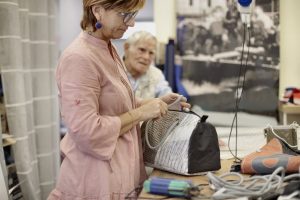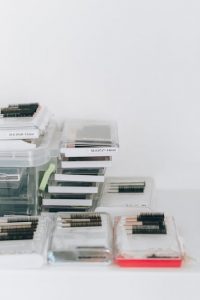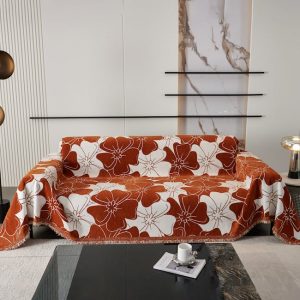Do You Hate Weaving In The Tails of A Crochet Blanket?
Crocheting is a beloved craft enjoyed by millions worldwide. From intricate blankets to cozy hats, the possibilities are endless. The tactile nature of crocheting, the satisfaction of creating something with your own hands, and the ability to express creativity through yarn and stitch are just some of the reasons why crocheting continues to captivate people of all ages and backgrounds. However, as any crocheter knows, finishing a project involves more than just tying off the final stitch. Weaving in the ends is a crucial step that can significantly enhance your work’s overall appearance and durability. I do not crochet, but all of my children do, and I have become the “official” weaver, and I love it. Here is how I like to do this and the tools I use.
Imagine a beautifully crocheted blanket, meticulously crafted with intricate patterns and vibrant colors. But upon closer inspection, you notice loose ends dangling from the edges, detracting from the overall aesthetic. These loose ends can unravel, become snagged on fabric, or even create unsightly bulges, diminishing the longevity and enjoyment of your creation. This is where the art of weaving in ends comes into play.
Weaving in ends is a technique that involves carefully securing the loose yarn tails within the fabric, creating a seamless and invisible finish. This seemingly simple yet essential step elevates your crochet work from amateur to professional. When done correctly, woven ends blend seamlessly into the fabric, ensuring your crochet creation remains beautiful and functional for years. The difference between a project with well-woven ends and one with loose ends is striking, showcasing the importance of mastering this technique for any crocheter.
This comprehensive guide will delve into weaving in crochet ends, providing detailed techniques, tips, and tricks to help you master this critical step. We’ll explore various methods, from basic techniques to more advanced strategies, catering to different project types and yarn weights. Whether you’re a beginner struggling with the basics or an experienced crocheter seeking to refine your skills, this guide will equip you with the knowledge and confidence to finish your projects with precision and elegance.
This guide will emphasize the importance of using the right tools and techniques to achieve a professional finish. We’ll also discuss how crocheters often encounter challenges when weaving in ends and provide practical solutions to overcome them. By the end of this guide, you’ll have a thorough understanding of the art of weaving in crochet ends, enabling you to create stunning and durable crochet projects that you can proudly display or gift.
Basic Weaving Techniques
The most common weaving technique involves using a crochet hook to weave the yarn end through the back loops of stitches on the wrong side of the fabric. This creates a secure and almost invisible finish. This method is particularly effective for projects with a single color or where the ends are woven into a seam or edge. Here’s a step-by-step guide:
1. **Cut the yarn, leaving a tail about 6 inches long.** This tail will be used for weaving. The length of the tail can be adjusted based on the yarn’s thickness and the project’s size. A longer tail is generally preferred for thicker yarns or larger projects, providing more room for maneuvering the hook and securing the end.
2. **Thread the yarn tail onto your tapestry needle or a latch hook (my preferred method) .**
3. **Insert the hook through several loops of the crocheted threads of the same color on the wrong side of the fabric.**
4. **Pull the yarn through all the loops you have passed your latch hook through.**
5. **Repeat steps 3 and 4 for the next stitch.**
6. **Continue weaving the yarn tail through the back loops of the stitches, working your way along the seam or edge.** This process is similar to crocheting, but instead of creating new stitches, you’re simply securing the yarn tail into existing stitches.
7. **Once you’ve woven the yarn tail for a few inches, cut it close to the fabric.** This creates a clean and secure finish.
Further Exploration
Weaving in ends may seem minor, but it’s crucial to creating a professional and durable crochet project. The finishing touch elevates your work from a simple handmade item to a piece of art. Imagine a beautifully crafted blanket with loose ends dangling or a delicate scarf with visible knots. These imperfections detract from the overall aesthetic and can compromise the piece’s longevity. Mastering these techniques can transform your finished projects from ordinary to extraordinary. Your crocheted creations will be visually appealing and withstand the test of time, providing you with years of enjoyment.
The art of weaving in ends goes beyond simply hiding the yarn tails. It’s about understanding the different methods and choosing the most appropriate one for each project. For example, the traditional method of weaving ends with a tapestry needle is ideal for most projects, but it may not be the best choice for delicate fabrics or intricate designs. In such cases, techniques like the ‘Russian join’ or ‘invisible join’ offer more subtle and secure solutions. Experimenting with various methods allows you to discover the ones that best suit your style and the specific requirements of each project.
Remember, patience is critical when it comes to weaving in ends. It’s a process that requires a steady hand and a keen eye for detail. Please don’t rush through it, as this can lead to loose ends or visible knots. Take your time, practice regularly, and you’ll find that your weaving skills will improve with each project. The more you practice, the more confident you’ll become in creating flawless finishes that enhance the beauty and durability of your crochet creations.
As you continue your crochet journey, embrace the art of weaving in ends as a vital part of the process. It’s not just about hiding loose ends; it’s about adding a professional touch and ensuring the long-lasting quality of your work. With time and effort, you can ensure that your crochet creations are beautiful and durable, bringing joy and satisfaction for years. So, the next time you finish a crochet project, don’t neglect the importance of weaving in ends. It’s a small step that can make a big difference in your work’s overall quality and longevity.

Photo by ROMAN ODINTSOV on Pexels








Your point of view caught my eye and was very interesting. Thanks. I have a question for you.
Your article helped me a lot, is there any more related content? Thanks!
I don’t think the title of your article matches the content lol. Just kidding, mainly because I had some doubts after reading the article.
Thank you for your sharing. I am worried that I lack creative ideas. It is your article that makes me full of hope. Thank you. But, I have a question, can you help me?